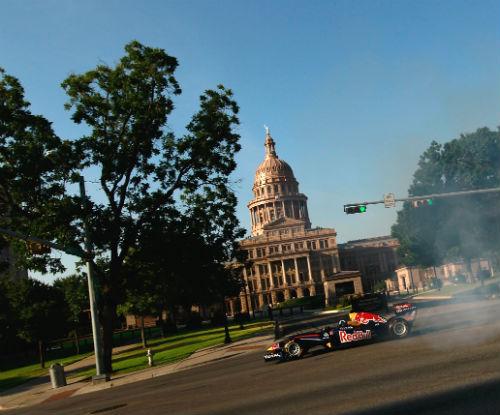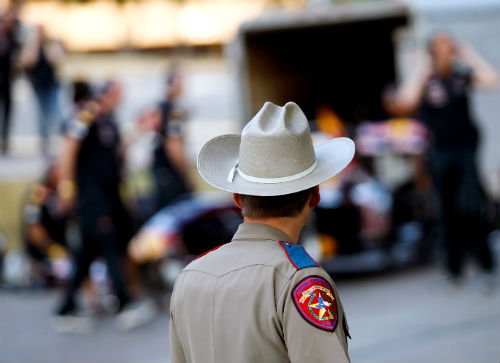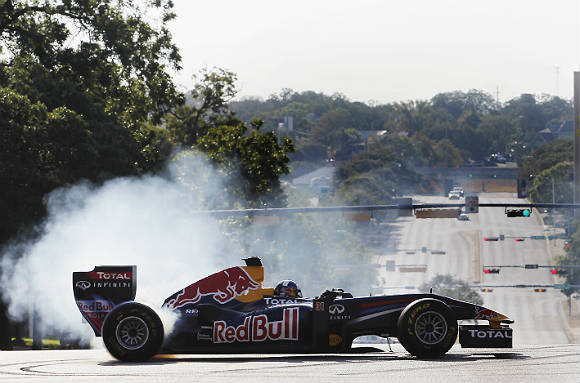 | « Back to article | Print this article |
Widespread opposition to the Formula One race
As the Texas capital prepares to host the first Grand Prix in the United States in five years, some in laid-back Austin say this weekend's glamorous race clashes with the city's soul.
-'F1 will never succeed in the US'
In this environmentally-conscious college town of 800,000, where the bumper stickers say "Keep Austin Weird" and there are no professional sports teams, there is widespread opposition to the Formula One race.
-Sahara Force India not thinking of sixth place now
Some sceptics have come around, embracing the race and the sleek parties that come with it, while others are still shaking their heads over fears of clogged streets, noisy helicopter traffic and a negative impact on the environment, all for a ritzy event they say is simply un-Austin.
"Many opponents said that this is kind of the wrong image - frivolous emissions, carbon and other pollutants into the air just for amusement purposes -- for a city that wants to be seen as the most sustainable city in the United States," said Tom Smith, director of the Texas office of Public Citizen, a nonprofit consumer advocacy group.
'It's just another thing that makes Austin weird'
Officials at Circuit of the Americas, which owns the new racetrack, say they're working to minimize the environmental impact of the event and point out that F1 innovations lead to more efficient passenger cars.
Texas Comptroller Susan Combs touts the economic impact of the event, which she says will generate some $220 million (139 million pounds) for the state.
And many Austinites are thrilled about the race at the 3.4-mile (5.5 kilometre), $400 million track facility southeast of town, as well as a downtown fan festival and concerts by Aerosmith and Enrique Iglesias.
"It's just another thing that makes Austin weird," said Julie Loignon, a spokeswoman for Circuit of the Americas, adding that F1 was too shiny, too chic for Austin, more of a Dallas-type thing.
"Austin is very European, with its politics, its progressive thinking. People are going to come here, buy their boots, let their hair down, and they're going to have a lovely time."
F1 has found hard to crack US over the years
F1 has not raced in the US since 2007, when the Grand Prix was held at Indianapolis, and teams are eager to return to a country that is a key market for sponsors and car manufacturers but one that the sport has found hard to crack over the years.
A second Grand Prix was planned for New Jersey in 2013 but has been postponed until 2014.
F1 is expected to race for a decade at the 20-turn Austin track featuring a steep climb to a hairpin Combs has called "that extraordinary drive up into the heavens."
The fact that the race is in Austin is due in large part to Tavo Hellmund, an Austin-born former race car driver who has a close relationship with F1 boss Bernie Ecclestone.
After working to bring the race to his hometown, Hellmund eventually parted ways with Circuit of the Americas, and there were such serious struggles among race organizers that in late 2011, construction on the track was halted prompting speculation the race may not happen.
"For a lot of us longtime Austinites, Formula One is hard to swallow," City Council Member Chris Riley wrote in the Austin American-Statesman last year. "We're not that big on fast cars; we're more into hybrids, electric vehicles, bikes and public transit."
Since then, Riley has warmed to the idea, mostly because the city and Circuit of the Americas signed an environmental agreement that calls for purchasing carbon offsets, limiting traffic, providing access for cyclists, planting trees, recycling and composting, and allowing electric vehicle research at the track.
'The most sustainable racetrack in the world'
The City Council's support of the project was needed to qualify the event for $25 million in state subsidies that race officials can seek after it happens.
"If this were just another race car venue, well then, that would detract from our character," Riley, who plans to bike to the race, said recently.
"On the other hand, if this site becomes known as being the most sustainable racetrack in the world and that's here in Austin, Texas, that's a lot closer to the character of the city that we love."
Edgar Farrera was brought on at Circuit of the Americas in January as what he believes is the first circuit sustainability director in the history of Grand Prix.
"We're not trying to tell people, 'If you want to do something to save the planet, go drive your car very fast,'" Farrera said.
Rather, he said, he's constantly thinking about how to minimize the impact of crowds, whose traffic and waste will have a bigger environmental impact than the two dozen F1 cars, each of which races on a single tank of gas.
And he delicately pointed out that it doesn't much matter to the environment whether crowds arrive for a sporting event or a music festival.
'This is a heavily greenwashed race'
Austin, which calls itself the Live Music Capital of the World, proudly hosts the Austin City Limits Music Festival and the South by Southwest music, film and interactive conferences.
Smith of Public Citizen said the track's environmental initiatives don't go far enough.
"This is a heavily greenwashed race," Smith said. He added: "As you can tell, I'm not real happy."
State Senator Kirk Watson, a Democrat who is a former Austin mayor, said F1 is just another way the city brings different people together.
"In the old days, it might have been rednecks sitting next to hippies," Watson told Reuters at an opening ceremony for the track.
"In this day and age, though, it's people from all over the world coming to enjoy the spirit of the town."

© Copyright 2025 Reuters Limited. All rights reserved. Republication or redistribution of Reuters content, including by framing or similar means, is expressly prohibited without the prior written consent of Reuters. Reuters shall not be liable for any errors or delays in the content, or for any actions taken in reliance thereon.




